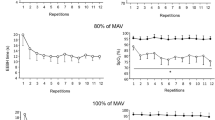Abstract
Eight male endurance runners [mean ± (SD): age 25 (6) years; height 1.79 (0.06) m; body mass 70.5 (6.0) kg; % body fat 12.5 (3.2); maximal oxygen consumption (V˙O2max 62.9 (1.7) ml · kg−1 · min−1] performed an interval training session, preceded immediately by test 1, followed after 1 h by test 2, and after 72 h by test 3. The training session was six 800-m intervals at 1 km · h−1 below the velocity achieved at V˙O2max with 3 min of recovery between each interval. Tests 1, 2 and 3 were identical, and included collection of expired gas, measurement of ventilatory frequency (f v ), heart rate (f c), rate of perceived exertion (RPE), and blood lactate concentration ([La−]B) during the final 5 min of 15 min of running at 50% of the velocity achieved at V˙O2max (50% −V˙O2max).␣Oxygen uptake (V˙O2), ventilation (V˙ E ), and respiratory exchange ratio (R) were subsequently determined from duplicate expired gas collections. Body mass and plasma volume changes were measured preceding and immediately following the training session, and before tests 1–3. Subjects ingested water immediately following the training session, the volume of which was determined from the loss of body mass during the session. Repeated measures analysis of variance with multiple comparison (Tukey) was used to test differences between results. No significant differences in body mass or plasma volume existed between the three test stages, indicating that the differences recorded for the measured parameters could not be attributed to changes in body mass or plasma volume between tests, and that rehydration after the interval training session was successful. A significant (P < 0.05) increase was found from test 1 to test 2 [mean (SD)] for V˙O2 [2.128 (0.147) to 2.200 (0.140) 1 · min−1], f c [125 (17) to 132 (16) beats · min−1], and RPE [9 (2) to 11 (2)]. A significant (P < 0.05) decrease was found for submaximal R [0.89 (0.03) to 0.85 (0.04)]. These results suggest that alterations in V˙O2 during moderate-intensity, constant-velocity running do occur following heavy-intensity endurance running training, and that this is due to factors in addition to changed substrate metabolism towards greater fat utilisation, which could explain only 31% of the increase in V˙O2.
Similar content being viewed by others
Author information
Authors and Affiliations
Additional information
Accepted: 8 December 1997
Rights and permissions
About this article
Cite this article
James, D., Doust, J. Oxygen uptake during moderate intensity running: response following a single bout of interval training. Eur J Appl Physiol 77, 551–555 (1998). https://doi.org/10.1007/s004210050375
Issue Date:
DOI: https://doi.org/10.1007/s004210050375




